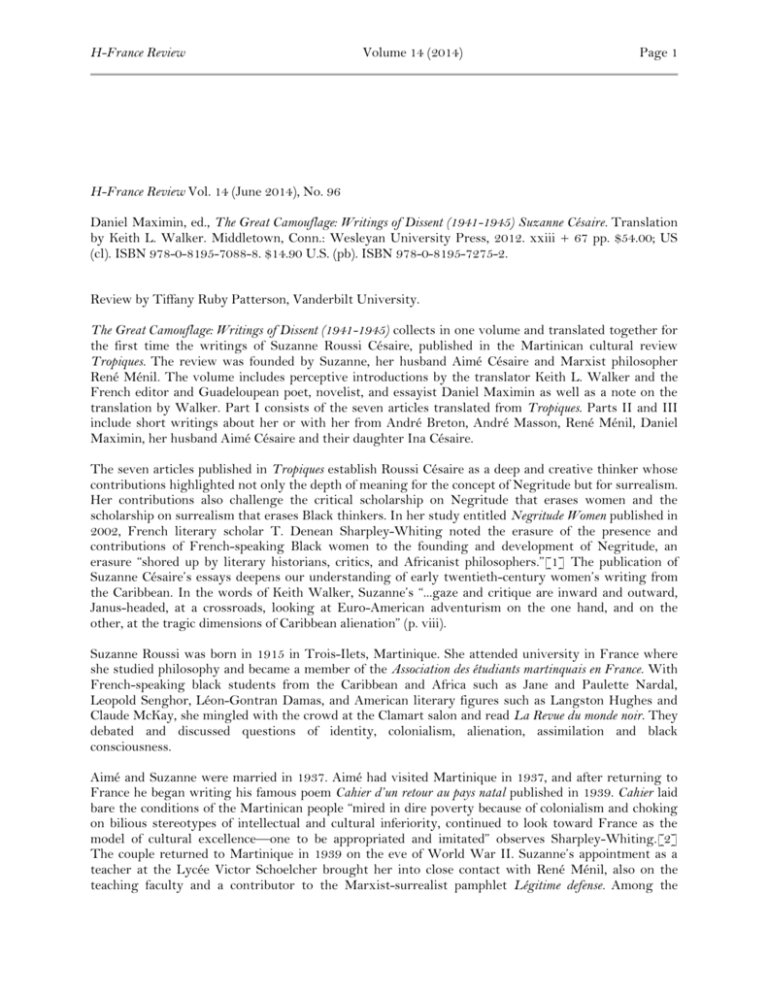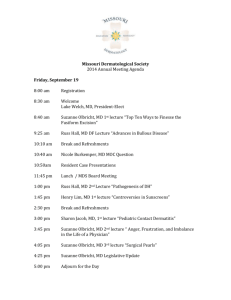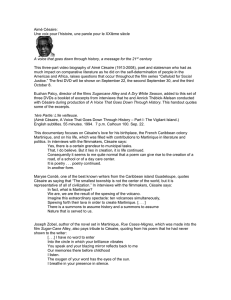
H-France Review
Volume 14 (2014)
Page 1
H-France Review Vol. 14 (June 2014), No. 96
Daniel Maximin, ed., The Great Camouflage: Writings of Dissent (1941-1945) Suzanne Césaire. Translation
by Keith L. Walker. Middletown, Conn.: Wesleyan University Press, 2012. xxiii + 67 pp. $54.00; US
(cl). ISBN 978-0-8195-7088-8. $14.90 U.S. (pb). ISBN 978-0-8195-7275-2.
Review by Tiffany Ruby Patterson, Vanderbilt University.
The Great Camouflage: Writings of Dissent (1941-1945) collects in one volume and translated together for
the first time the writings of Suzanne Roussi Césaire, published in the Martinican cultural review
Tropiques. The review was founded by Suzanne, her husband Aimé Césaire and Marxist philosopher
René Ménil. The volume includes perceptive introductions by the translator Keith L. Walker and the
French editor and Guadeloupean poet, novelist, and essayist Daniel Maximin as well as a note on the
translation by Walker. Part I consists of the seven articles translated from Tropiques. Parts II and III
include short writings about her or with her from André Breton, André Masson, René Ménil, Daniel
Maximin, her husband Aimé Césaire and their daughter Ina Césaire.
The seven articles published in Tropiques establish Roussi Césaire as a deep and creative thinker whose
contributions highlighted not only the depth of meaning for the concept of Negritude but for surrealism.
Her contributions also challenge the critical scholarship on Negritude that erases women and the
scholarship on surrealism that erases Black thinkers. In her study entitled Negritude Women published in
2002, French literary scholar T. Denean Sharpley-Whiting noted the erasure of the presence and
contributions of French-speaking Black women to the founding and development of Negritude, an
erasure “shored up by literary historians, critics, and Africanist philosophers.”[1] The publication of
Suzanne Césaire’s essays deepens our understanding of early twentieth-century women’s writing from
the Caribbean. In the words of Keith Walker, Suzanne’s “...gaze and critique are inward and outward,
Janus-headed, at a crossroads, looking at Euro-American adventurism on the one hand, and on the
other, at the tragic dimensions of Caribbean alienation” (p. viii).
Suzanne Roussi was born in 1915 in Trois-Ilets, Martinique. She attended university in France where
she studied philosophy and became a member of the Association des étudiants martinquais en France. With
French-speaking black students from the Caribbean and Africa such as Jane and Paulette Nardal,
Leopold Senghor, Léon-Gontran Damas, and American literary figures such as Langston Hughes and
Claude McKay, she mingled with the crowd at the Clamart salon and read La Revue du monde noir. They
debated and discussed questions of identity, colonialism, alienation, assimilation and black
consciousness.
Aimé and Suzanne were married in 1937. Aimé had visited Martinique in 1937, and after returning to
France he began writing his famous poem Cahier d’un retour au pays natal published in 1939. Cahier laid
bare the conditions of the Martinican people “mired in dire poverty because of colonialism and choking
on bilious stereotypes of intellectual and cultural inferiority, continued to look toward France as the
model of cultural excellence—one to be appropriated and imitated” observes Sharpley-Whiting.[2]
The couple returned to Martinique in 1939 on the eve of World War II. Suzanne’s appointment as a
teacher at the Lycée Victor Schoelcher brought her into close contact with René Ménil, also on the
teaching faculty and a contributor to the Marxist-surrealist pamphlet Légitime defense. Among the
H-France Review
Volume 14 (2014)
Page 2
students were Frantz Fanon, a future theorist of oppression and adopted Algerian revolutionary and
Edouard Glissant, the creator of the concept of Antillanité.
A repressive intellectual climate consumed the island of Martinique after the Césaires returned as the
Antilles and all French colonies were drawn into the orbit of a German occupied France at Vichy
administered by Marshal Henri Philippe Pétain at its helm. In the 1930s, the French right had
vehemently opposed the presence of black colonials in their midst. The Negritude Movement, founded
by the Césaires, Leopold Senghor and Léon-Gontran Damas challenged the French right during the
1930s highlighting particularly the racism of the colonial regimes and the oppressions wrought by
colonialism.
Events in Europe also transformed the political environment for Blacks in this period of increasing
racial tensions. Fascism erupted in Germany, Spain, and Italy. In 1940, France signed an Armistice with
Germany and became collaborators with the Nazi regime. The agreement required that France be
partitioned and forced to pay a daily indemnity of 400 million francs, a burden shared by the colonies.
For Suzanne Césaire and her associates, notes Walker, “things could get no worse and…they had
nothing further to lose as the shadow of Nazism advanced into the Caribbean with the installation of
Pétain’s governors, Admiral Robert in Martinique and Admiral Saurin in Guadeloupe” (p. ix).
Progressive and political dissidents were exposed to the capricious workings of repressive rule, as
Walker notes: “Denunciations, deportations, disappearances, executions, and murders were routine
practices under the fascist Pétainist régime. It was imperatively the time of dissent, and especially for
dissident thinking.” Walker continues, “It was an ‘urgent time...a time to dare: to dare to know oneself, to
dare to confess to oneself what one is, to dare to ask what one wants to be’” (p. ix). In this climate,
Suzanne dared to dissent and in so doing became a key figure in the political conversations in her native
land.
In her first essay published in Tropiques, “Leo Frobenius and the Problem of Civilizations,” Suzanne
draws on the work of Frobenius, historian, archaeologist and ethnologist, to explore the meaning of the
human. Frobenius studied the culture and history of African civilizations “and created for himself, as he
asserts, an African soul, ways of thinking and feeling that are specifically African” (p. 4). For Suzanne,
Frobenius’s examination of an African soul is more than seeking roots in an African homeland. For her,
“Africa does not mean for us solely an expansion toward the elsewhere, but also a deepening of our
knowledge of ourselves” (p. 6). She discovers in this work an astute critique of the Enlightenment:
“In effect, Frobenius discovered that the idea of uninterrupted progress, cherished by the nineteenth
century which showed civilization progressing along a single line from primitive barbarism to modern
high culture, was a false idea. Humanity does not have a will to achieve perfection. Moreover, it does not
create for itself a civilization that aspires to ever-higher levels. It goes forth...in multiple directions, from
one ‘shock,’ to the next just as the vital force goes from mutation to mutation among the diversity of
living species” (p. 7).
Suzanne’s critique was unusual in her day but commonplace in our own. Her thinking was decolonial
and historical, troubling the narrative on which France built its repressive colonialisms, the sacrosanct
democratic principles of liberty, equality, and fraternity.
In her essay “Poetic Destitution,” Suzanne rebukes those Martinicans who have failed to recognize
themselves as a Caribbean people for creating art that is imitative of Europeans, and not culturally
authentic. She opines:
“Hammock literature. Literature made of sugar and vanilla. Tourist literature. The Blue Travel Guide
and General Confederation of Labor. Poetry, not in the least...real poetry lies elsewhere. Far from
rhymes, laments, sea breezes, parrots. Stiff and stout bamboos changing direction, we decree the death
H-France Review
Volume 14 (2014)
Page 3
of sappy, sentimental, folkloric literature. And to hell with hibiscus, frangipani, and bougainvillea.
Martinican poetry will be cannibal or it will not be” (p. 27).
Continuing with the theme of cultural mimicry and emptiness in her essay “The Malaise of Civilization,”
Suzanne argues that “...the Martinican has failed because, unaware of his real nature, he tries to lead a
life that is not his own” (p. 31). She cites a litany of repressive polices beginning in the era of slavery and
concludes that “the fundamental goal of the colored man became assimilation. And with overwhelming
force, a disastrous confusion takes place in his mind: liberation means assimilation” (p. 31). This obsession
with assimilation led to an almost manic desire for Frenchness and middle-class status. She writes, “The
race for economic fortune, diplomas, unscrupulous social climbing. A struggle shrunken to the standard
of being middle class. The pursuit of monkeyshines, Vanity Fair” (p. 32). Her analysis is as precise as a
razor’s edge and as hard hitting as an axe. She plumbs the colonial mind and uncovers a sinister
consequence of slavery and colonialism.
In 1943, she penned her essay “Surrealism and Us.” The goal of surrealism as defined by Breton was “to
free the mind from the shackles of absurd logic and so-called Western reason” (p. 35). Quoting Breton
further she says:
“In art as in life, the surrealist cause is the cause of freedom. Today more than ever, to draw one’s
inspiration abstractly from freedom, or to celebrate it in conventional terms, is to do it a disservice. In
order to enlighten the world, freedom must make itself flesh and blood and, toward that end, must be
reflected and recreated in language, in the word” (p. 35).
Negritude for both Césaires was seasoned with surrealism and it was a weapon in the pursuit of
freedom. But Suzanne’s Negritude was not romantic or ahistorical. Africa was a part of the Antillean
past and certainly a significant aspect of culture. But time mattered as well and she understood the
historical changes that created a multi-ethnic Caribbean. She argued therefore, “It will be time finally to
transcend the sordid contemporary antinomies: Whites-Blacks, Europeans-Africans, civilizedsavage....Colonial idiocies will be purified by the welding arc’s blue flame” (p. 38). Her Negritude, unlike
Aimé’s, included the specific situation of Martinique and the rest of the Americas. As Sharpley-Whiting
notes, “Suzanne Césaire’s Negritude set in motion the idea of the plurality of Martinican origins as a
result of historical processes, a Negritude that would definitely offer intellectual sustenance to the
hybridizing theories of Antillanité and Creolité.”[3] And in the words of the editor Daniel Maximin,
“The creative strength of Suzanne Césaire is to have understood very early on the universal dimension
at work over three centuries that constructed her Caribbean, the inscription of a history and a geology
accommodating to misfortunes as well as to relaxations, to paradises regained as well as to immigrant
cataclysms” (p. xxxi).
Suzanne’s first six essays flow seamlessly to her last, “The Great Camouflage.” Exposing the camouflage
upon which colonialism rests she turns to language as a weapon to exact freedom. On May 10, 1945, the
Vichy regime wrote a letter to the editors to cease publication, accusing the editors of poisoning minds
and sowing the seeds of hatred. They withheld paper to ensure the demise of the journal. The editors
wrote back on May 12, 1945. Lieutenant Bayle, chef du service d’information, called the editors racists,
sectarians, revolutionaries, traitors and ingrates. Suzanne and her associates responded thusly:
“Fort-de-France, May 12, 1943
To: Lieutenant-Commander Bayle
Dear Sir,
We are in receipt of your indictment against Tropiques.
H-France Review
Volume 14 (2014)
Page 4
“Racists,” “sectarians,” “revolutionaries,” “ingrates and traitors to the fatherland,” “poisoners of minds,”
none of these epithets are in essence repugnant to us.
“Poisoners of minds,” like Racine, according to the gentlemen at Port Royal.
“Ingrates and traitors to our so very good fatherland,” like Zola according to the reactionary press.
“Revolutionaries,” like Victor Hugo who wrote the “Châtiments.”
“Sectarians,” passionately so, like Rimbaud and Lautréamont.
“Racists,” yes. Racism like that of Toussaint-Louverture, Claude McKay, and Langston Hughes—
against the racism like that of Drumont and Hitler.
As for the rest, expect neither a plea nor vain recriminations, nor even debate.
We do not speak the same language.
Signed: Aimé Cesaire, Suzanne Césaire, Georges Gratiant, Aristide Maugée, René Ménil, Lucie Thésée”
This is the environment in which Suzanne Césaire explored her concerns regarding colonial power
relations, identity, and race. Keith Walker’s perceptive introduction identifies the concepts that guide
her thinking and skillfully guides the reader through her essays and the contributions of family
members and thinkers close to Suzanne. He argues that “each of her seven articles teases out questions
emanating from the nodal concept of camouflage, with its attendant phenomena of blindness and
imperative for lucidity. In her diagnostic, Césaire grapples with deception, self-deception, the economic
slip-knot of the post-slavery debt system, political smokescreens, inauthenticity, bad faith, psychological
and affective aberration, and cultural zombification” (p. vii). This is “The Great Camouflage,” the lie(s)
upon which colonialism and slavery were built: the complete deception of racial superiority and
inferiority and the violence that buttressed the lie(s).
The twin introductions by Keith Walker and Daniel Maximin and the commentaries by friends, family
and intellectuals set this collection apart from many others. It gives the reader a deeper appreciation for
Suzanne Césaire the political thinker, the wife, mother, and woman. The entire collection places Suzanne
Césaire in the company of brilliant twentieth-century thinkers on the strength of seven essays. As
Maximin observes,
“…she was of that generation of young women conquering the obstacles to freedom and dignity, like
their elders the Nardal sisters who held a musical and literary salon, like her two friends Jenny Alpha,
the Martinican actress, and Gerty Archimède, lawyer and great historical figure of Guadeloupe, for
which she was the first woman deputy representative in 1945, a position Suzanne Césaire could have
taken as well” (p. xxxii).
Suzanne Césaire died in 1966 from a brain tumor. Her health was fragile and at the time of her death she
was separated from Aimé, her beloved husband, a separation she requested. What she would have
produced had she continued to write after 1945 or lived beyond the age of fifty, we will never know. But
one thing is certain: Suzanne Césaire was a bright and shining light and a brilliant dissident for all time.
The Great Camouflage is a spectacular achievement.
H-France Review
Volume 14 (2014)
Page 5
LIST OF ESSAYS
Keith L. Walker, “Translator’s Introduction: Suzanne Césaire and the Great Camouflages”
“Translator’s Note”
Daniel Maximin, “Editor’s Introduction: Suzanne Césaire, sun-filled fountain”
“Leo Frobenius and the Problem of Civilizations”
“Alain and Esthetics”
“André Breton, Poet”
“Poetic Destitution”
“The Malaise of a Civilization”
“1943: Surrealism and Us”
“The Great Camouflage”
Daniel Maximin, “The Creole Dialogue”
André Masson, “Antille”
“The Creole Dialogue between André Breton and André Masson”
René Ménil, “Let Poetry Go”
Daniel Maximin, “Aimé-Suzy”
Aimé Césaire, “Hair”
Aimé Césaire, “Seismic Shift”
Aimé Césaire, “Son of Thunder and Lightning”
Ina Césaire, “Suzanne Césaire, My Mother”
NOTES
[1] T. Denean Sharpley-Whiting, Negritude Women (Minneapolis: University of Minnesota Press,
2002), p. 80.
[2] Ibid., p. 81.
[3] Ibid., p. 83.
Tiffany Ruby Patterson
H-France Review
Volume 14 (2014)
Page 6
Vanderbilt University
t.ruby.patterson@Vanderbilt.edu
Copyright © 2014 by the Society for French Historical Studies, all rights reserved. The Society for
French Historical Studies permits the electronic distribution of individual reviews for nonprofit
educational purposes, provided that full and accurate credit is given to the author, the date of
publication, and the location of the review on the H-France website. The Society for French Historical
Studies reserves the right to withdraw the license for edistribution/republication of individual reviews
at any time and for any specific case. Neither bulk redistribution/ republication in electronic form of
more than five percent of the contents of H-France Review nor re-publication of any amount in print
form will be permitted without permission. For any other proposed uses, contact the Editor-in-Chief of
H-France. The views posted on H-France Review are not necessarily the views of the Society for
French Historical Studies.
ISSN 1553-9172







